Borussia Dortmund’s 2020/21 Bundesliga campaign has been nothing short of a disappointment. They started the previous season strong, before falling off the pace and finishing 13 points behind eventual winners Bayern Munich. But this season, due to a terrible run of form which has led to Lucien Favre’s sacking, Dortmund are already five points off the top and we’re not even at the halfway point.
This gap could be even more if it wasn’t for a return to form under ex-West Ham assistant coach Edin Terzić. Whilst Dortmund do already look stronger than they did in Favre’s final days under Terzić, they still don’t look like serious title contenders, and the remit for Terzić will have been to hold down the fort, ensure they qualify for the Champions League, and Dortmund can spend the meantime planning the long-term future of the club. The name on everyone’s lips for the vacant permanent Head Coach position is Borussia Monchengladbach’s current manager, Marco Rose. This would certainly be more of a move back to a similar style of football under Jurgen Klopp and Thomas Tuchel and would likely be a welcome appointment from the Dortmund faithful.
Nevertheless, the new head coach, whoever that may be, will have their hands full, looking to fix some of Dortmund’s shortcomings under Favre. And let’s be clear, the issues highlighted in this article are problems that were long seen under Favre. These are long standing issues and not quick fixes.
Favre was never quite at home at Dortmund. His laboured and slow, passing approach was a move away from the high-energy counter-pressing football Dortmund had become accustomed to, and it always seemed like an odd fit. It felt like Dortmund had been waiting for a while to pull the plug on Favre’s reign, and the 5-1 loss to Stuttgart back in December was the last straw.
The changing room appeared to give up on the tactics of the Head Coach with the likes of Mats Hummels and Marco Reus, prominent figures within the team, publicly questioning Dortmund’s shortcomings under the coach. Even though Dortmund don’t have the budget to compete on those terms with Bayern Munich, there are still great expectations at this team, and the new coach will have to put a suitable style of football in place, along with getting the senior, experienced players on board to ensure the club culture is right.
This analysis if the first in a series of three, looking at where Dortmund need to improve. This specific tactical analysis will highlight the key defensive shortcomings of this Dortmund side.
Statistics
It’s no secret that there have been defensive issues for some time at Dortmund. A characteristic of the Favre regime was a loss of concentration from the defence in key times, or just a general lack of organisation that preceded the moments before an opposition goal.
We can begin to notice a concerning pattern when we look at their statistics from last season. For example, Dortmund had the second-lowest expected goals against in the league for the 2019//20 season..

The only issue is, whereas Bayern were outperforming against their xGA of 38.56 by having only conceded 32 goals, Dortmund were underperforming against their xGA of 39.16 by having conceded 41.
If we were then to look at the teams with the lowest goals conceded we can see that Leipzig and Monchengladbach both conceded less goals than Dortmund, and were both outperforming against their own xGA’s respectively. Out of this top four, Dortmund were the only side to be underperforming defensively.

This season they are faring slightly better with an xGA of 18.92, actually conceding 19, so at least they are conceding the amount they should be statistically speaking, but it still leaves them fourth in the table. It’s difficult to be a serious title contender with a leaky defence.
However, there have been improvements this season, with them conceding less shots against on average, winning more defensive duels and aerial duels, making more interceptions and more clearances. Of the 19 games in all competitions that Favre took charge of this year, they kept 10 clean sheets. This doesn’t strike as a side that are poor at the back. Yet, in the nine games where they didn’t keep a clean sheet, they conceded a total of 22 goals, therefore conceding 2.44 goals per game in these fixtures. For Dortmund to succeed they can’t have that level of inconsistency defensively, and winning games where they’re conceding this amount of goals just isn’t achievable on a consistent basis. Of the games where Dortmund conceded this season under Favre they won only two games from nine instances, drawing another two, and losing the other five. This has left them with eight points from nine games where they have conceded.
It’s far too early to comment on whether Terzić has improved Dortmund defensively, and they’ve conceded four in his five games in charge thus far. However, it is pretty damning that a man who was an assistant coach under Favre instantly changed from the preferred back three set-up to play with a back four.
There had been questions for some time about the use of the back three, which admittedly Favre used far less this season, but still enough. Whilst Hummels is an experienced centre-back, 35-year-old right-back Lukasz Piszczek was being used pretty frequently in the back three, as was the versatile Emre Can, whilst Dan Axel-Zagadou and Manuel Akanji fought for minutes as well.
Terzić instantly changed this by playing with a back four, preferring Akanji to partner Hummels, with Raphaël Guerreiro and Thomas Meunier in the full-back positions.
Over-playing without assessing the danger
Favre’s approach in possession wasn’t exactly keeping with previous Dortmund managers’. He preferred a more laboured, slow build-up approach, with plenty of passes, perhaps when there was the opportunity to play forward quicker.
This commitment to playing in such a way meant that teams were wary of pressing Dortmund high, knowing they there was the risk of being played around easily. However, this approach led to lapses of concentration, or just frankly bizarre decisions to play out when a team actually pressed high, with a strong, organised first line and second line of press.
We can see an example of this below from the second goal Dortmund conceded in Favre’s last game against Stuttgart, where the away side have three players pressing the immediate space around two of Dortmund’s players who are sharing possession. The failure to recognise the very apparent danger in this situation led to them conceding.
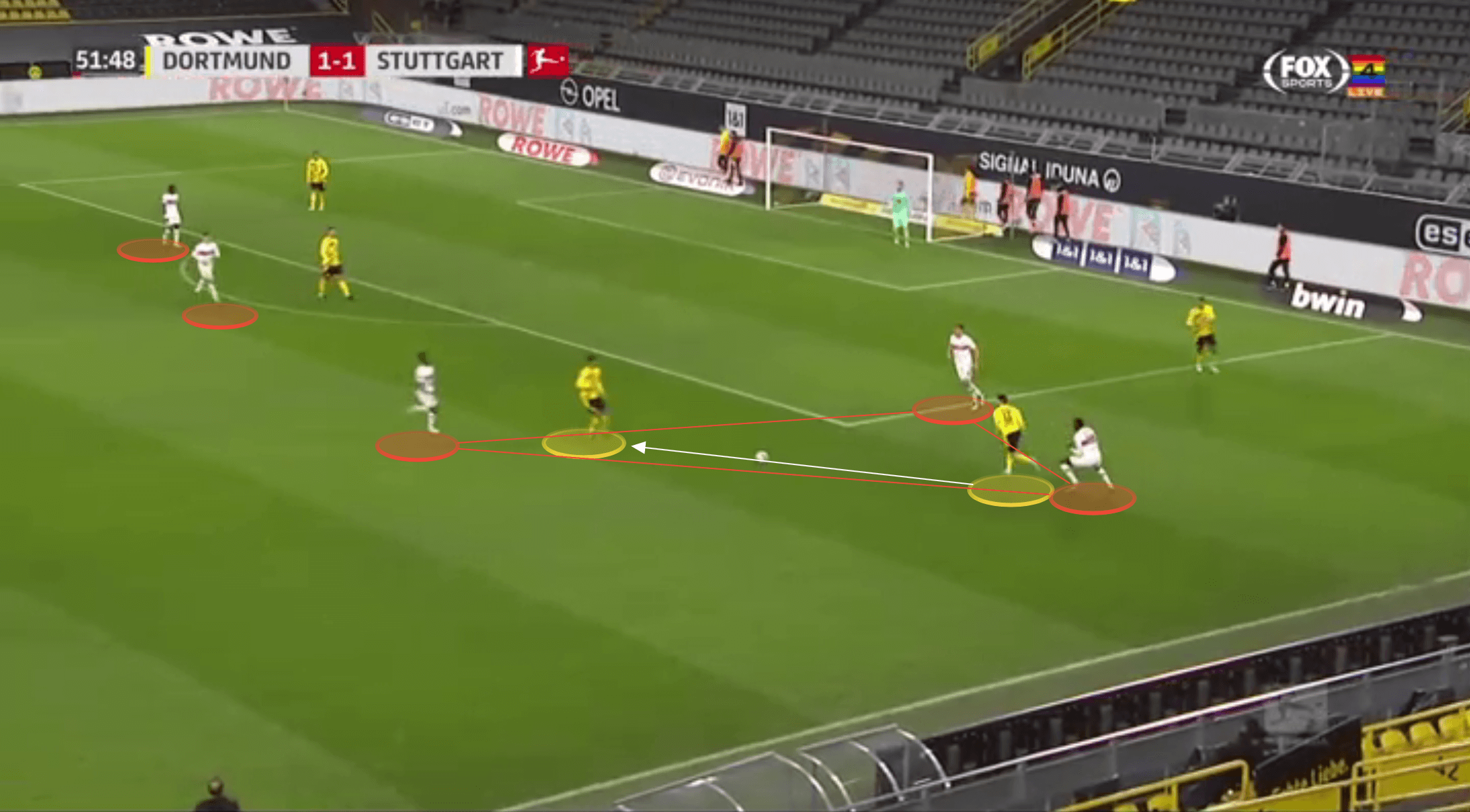
But this wasn’t an isolated issue. We can see an almost identical example but from the opposite flank from earlier this season, in a Champions League fixture away at Lazio.
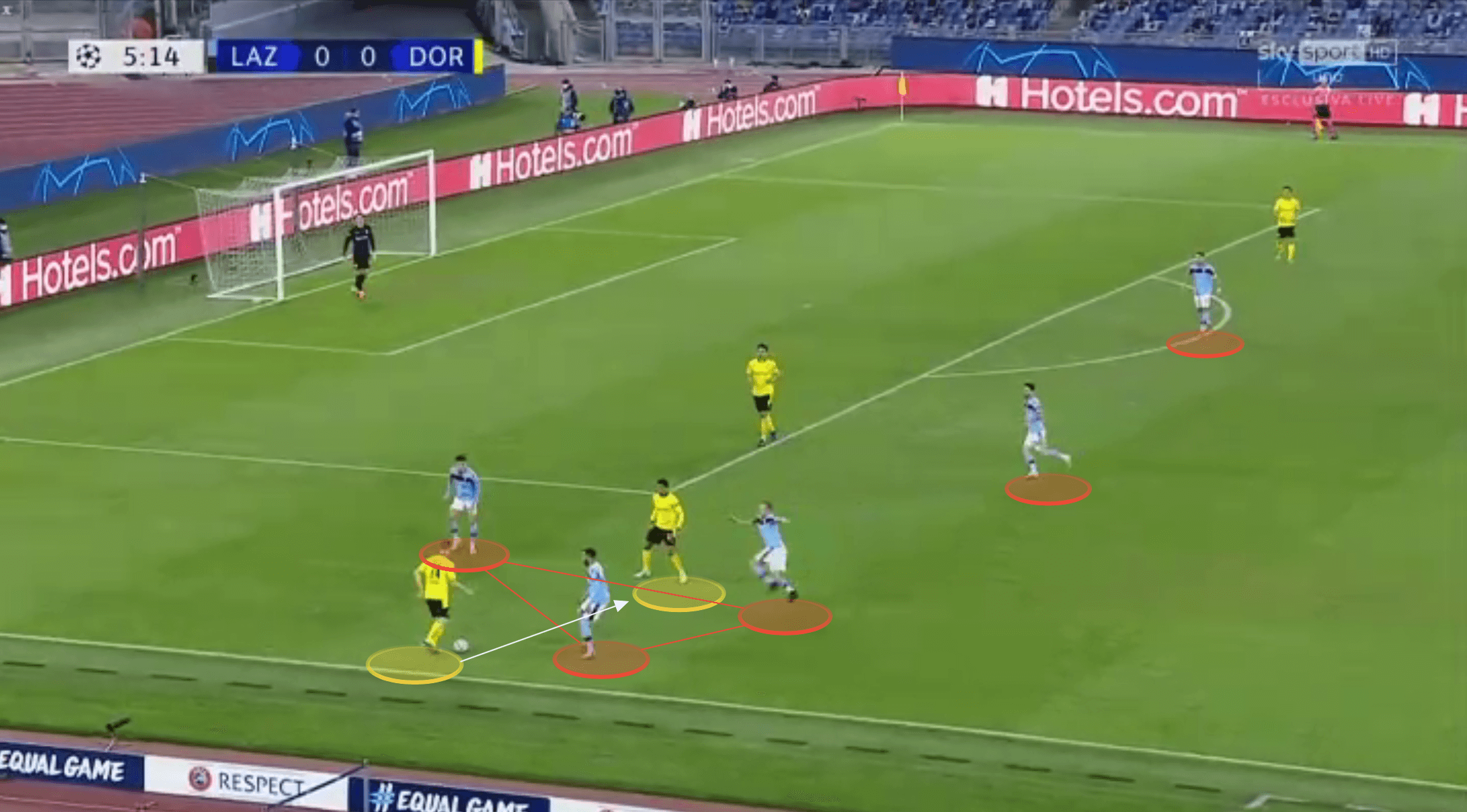
Whilst it’s admirable to be committed to playing in this way, there was clearly a failure to recognise when a more vertical approach to their build-up play was necessary.
Perhaps there’s a lack of anticipation of the defensive transition as well. This is further highlighted as this play develops. Raphaël Guerreiro is neither wide or narrow, and isn’t a realistic option for the ball-carrier.
As the ball is lost it’s so easy for the Lazio forward to steal inside the 18-yard-box and latch onto the simple through pass.
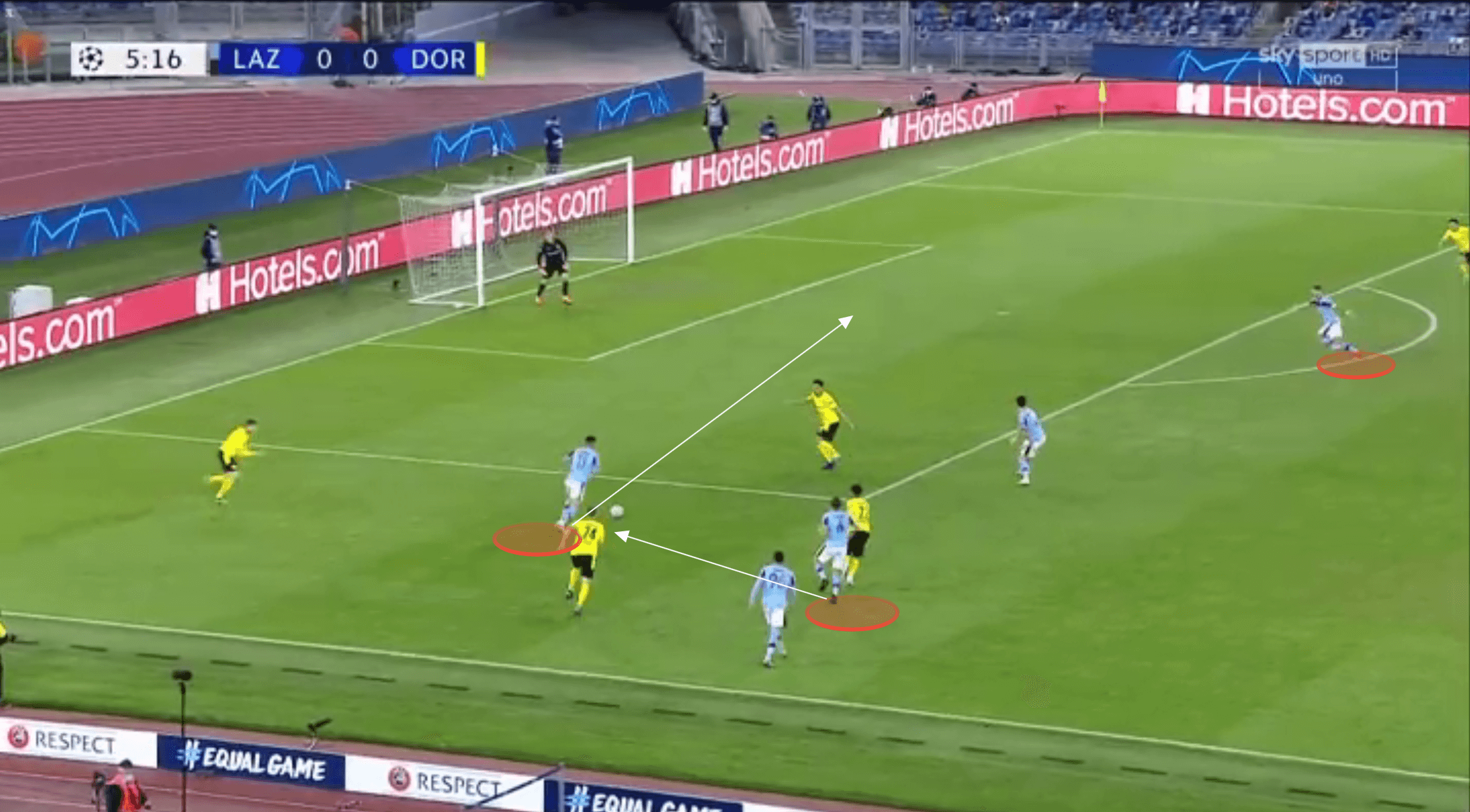
This also isn’t just a problem seen when playing out from goal-kicks, but the width provided from the back three can leave them susceptible to counter-attacks if the ball is lost further up the pitch. Below is an example against Bayern where the ball is played inside to Thomas Delaney who receives with his back to goal and without scanning. Delaney is dispossessed and Bayern are able to overload the central defender with two players already inside the back three, as we can see.
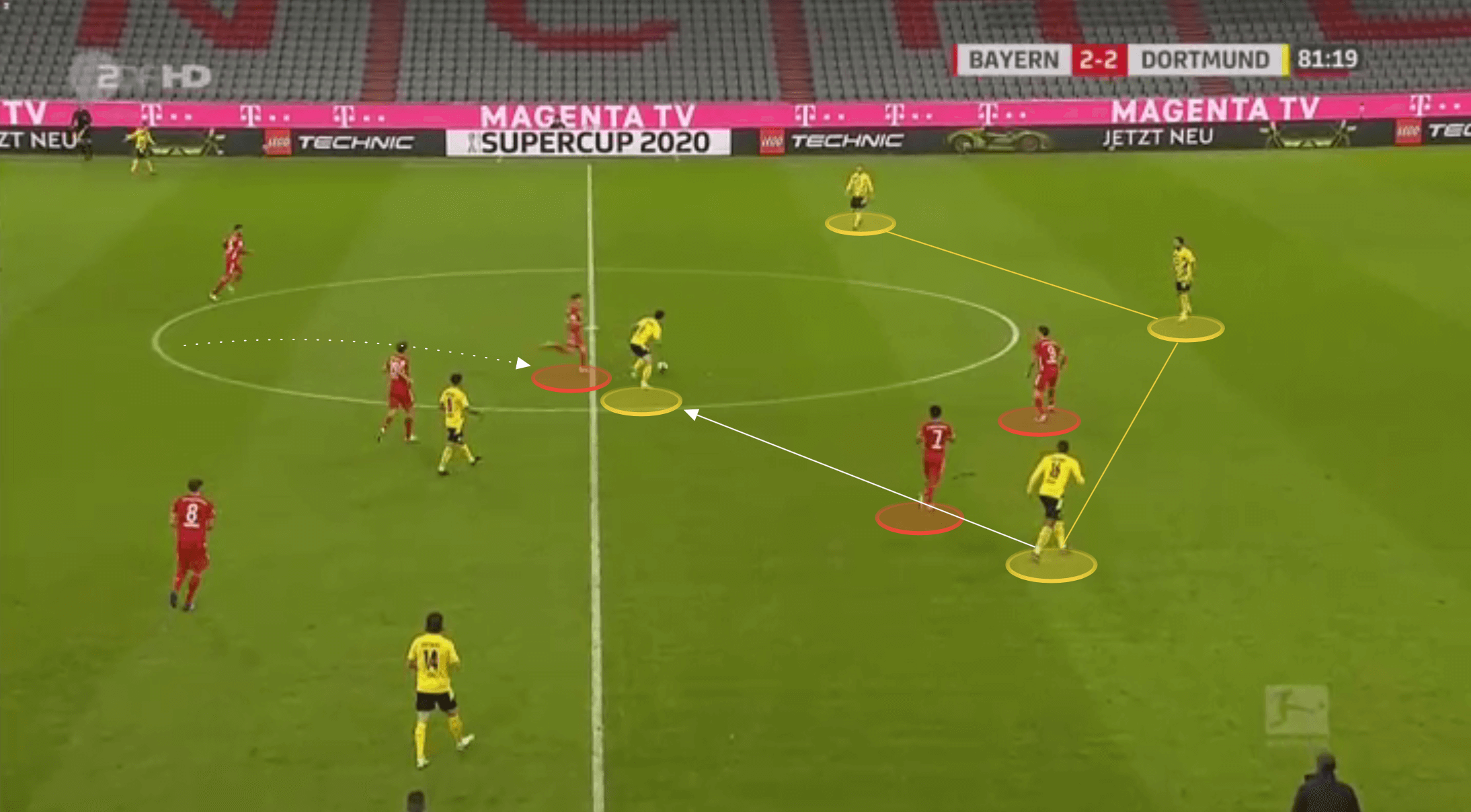
Vulnerable on the counter-attack
This moves us on to their all-round vulnerability on the counter. For a side that have counter-attacked with such prolificness in years gone by, and even now possessing players like Jadon Sancho and Erling Haaland who are so devastating in this area of the game, Dortmund are far too susceptible to this form of attack themselves.
Too often are they left open for a quick, direct counter. In the two examples shown below a ball is able to be played directly through the central channel of the pitch. Whilst the centre-backs are undoubtedly caught off-guard and are certainly too wide in their starting positions in the second image, there is no central protection in front of them.
In the image below, a pivot sitting between the back line and the midfield should be able to cut this pass out, or at least use their presence to prevent this pass being attempted.
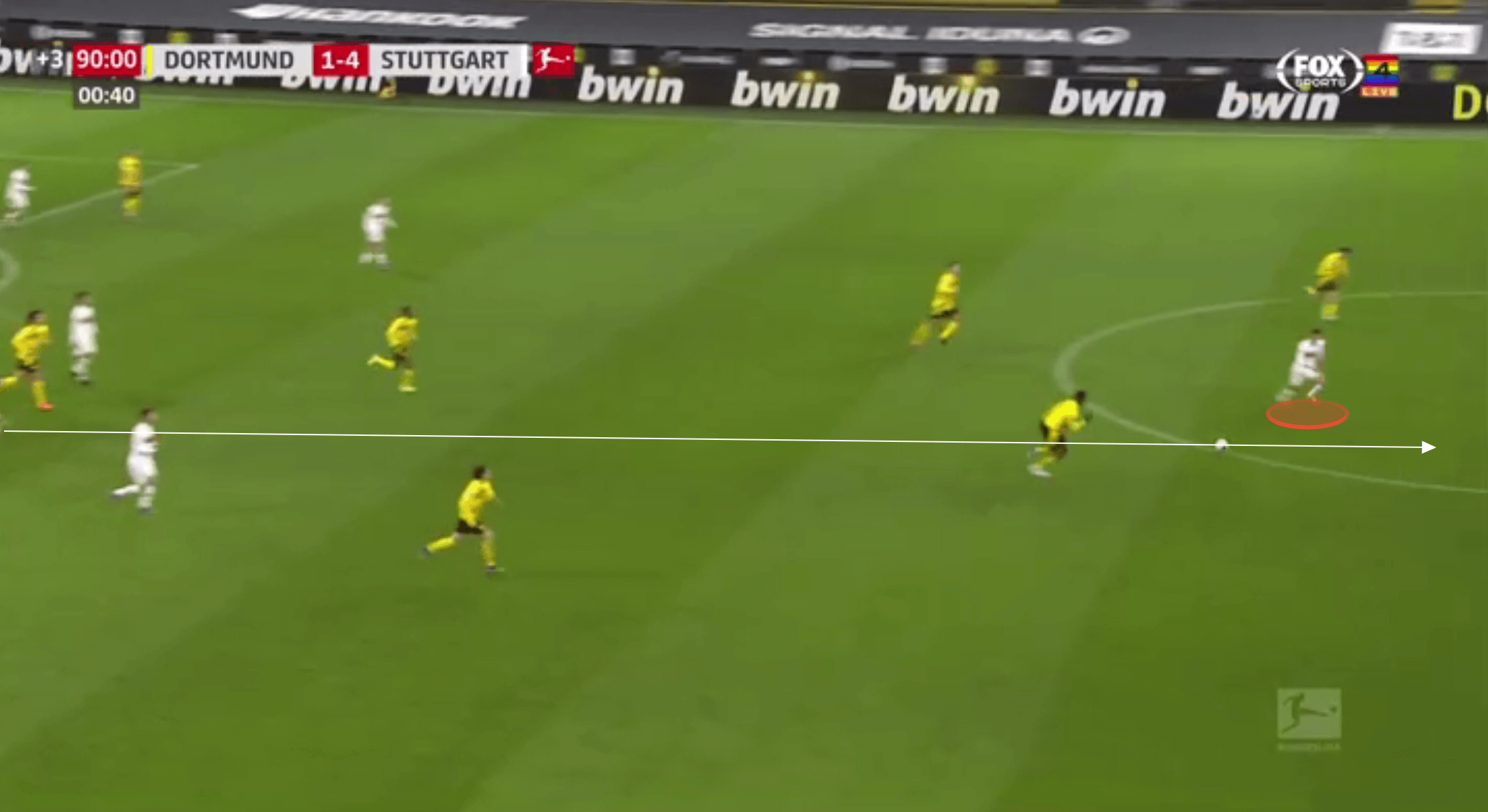
Whereas in this image below, Robert Lewandowski is able to receive in the space between midfield and defence, again with no Dortmund player bridging this gap. Bayern are able to quickly overload Dortmund’s centre-back pairing and score on the counter in this instance too.
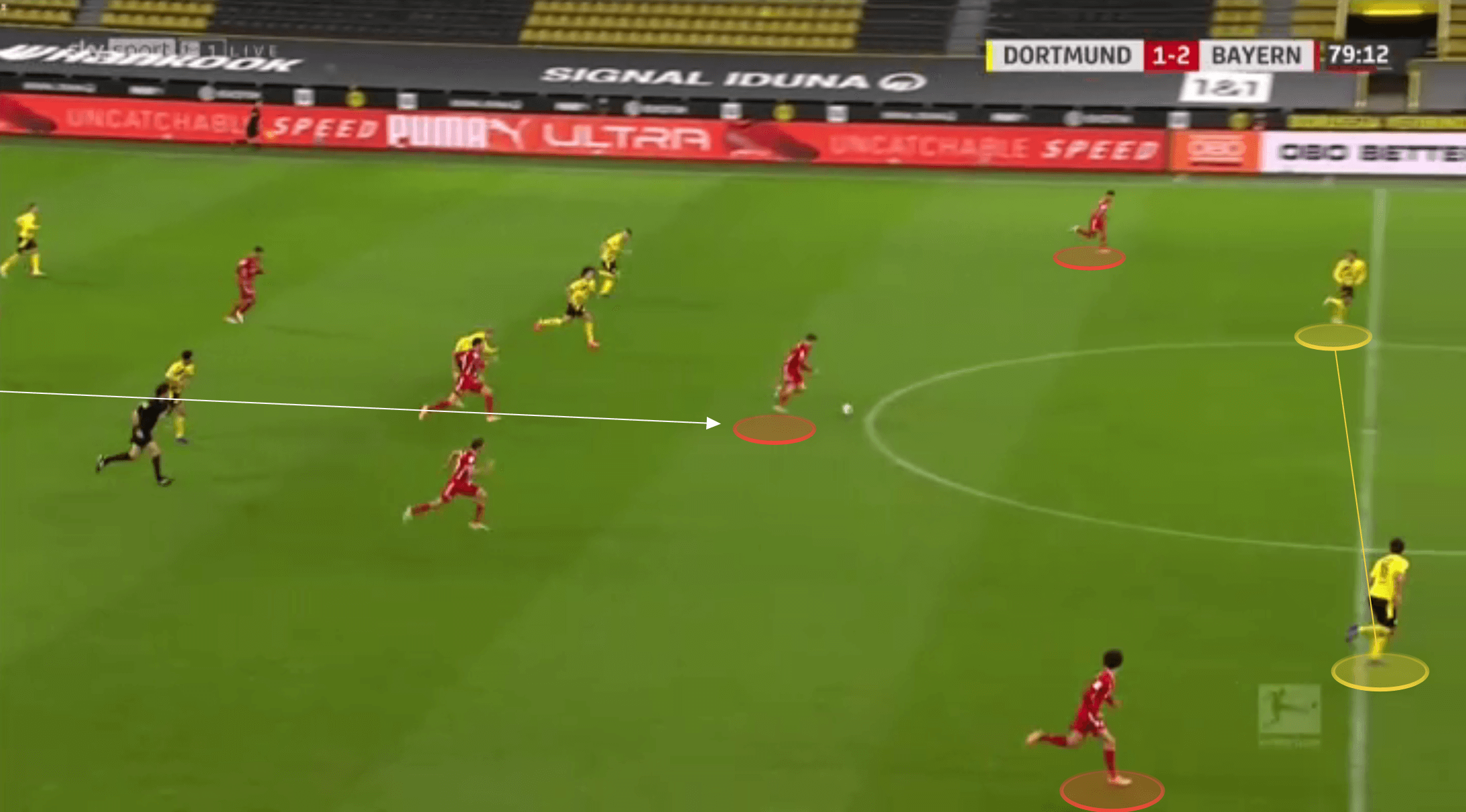
The lack of organisation against quick breaks is apparent with Dortmund’s midfield not recovering quick enough and leaving their high defensive line to be exposed by simple through passes.
There are still elements that can be improved on by the defence though. Below we can see Dortmund’s centre-back go to challenge the ball-carrier, despite no ample coverage behind him, and Marco Reus tracking back on the far side is look at Serge Gnabry in the middle of the pitch, who is moving into an offside position, totally unaware of the overlapping player outside.
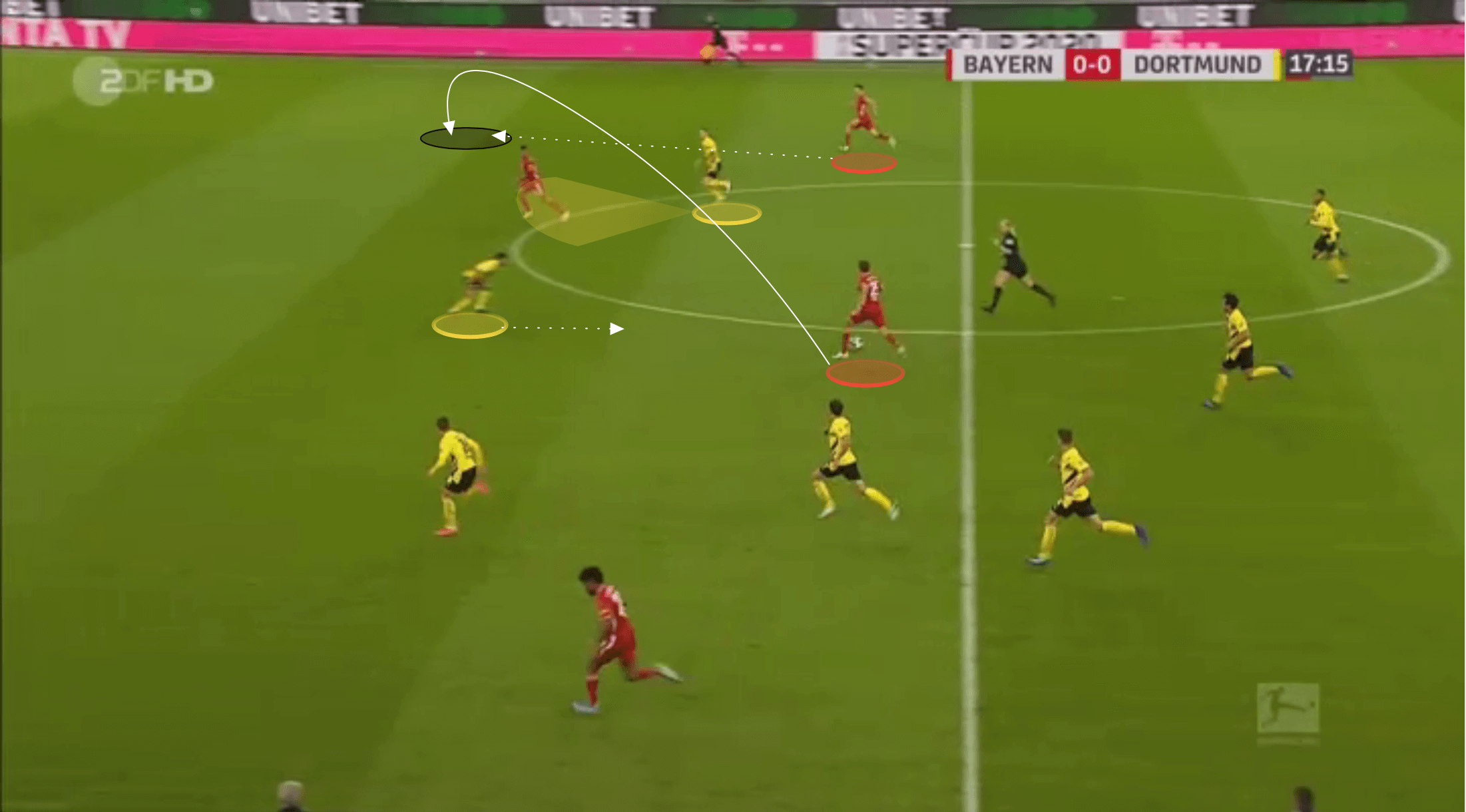
We can see a similar example of their high line being caught on the break against Augsburg. This time they are at least more organised as a unit, but they are completely flat, and we can see how Manuel Akanji who is highlighted, has his body facing towards the ball. Knowing there is an attacker making a run behind him, there is no benefit to him being positioned in this way. The centre-back is taken out by the lofted pass over the top, and Augsburg score.
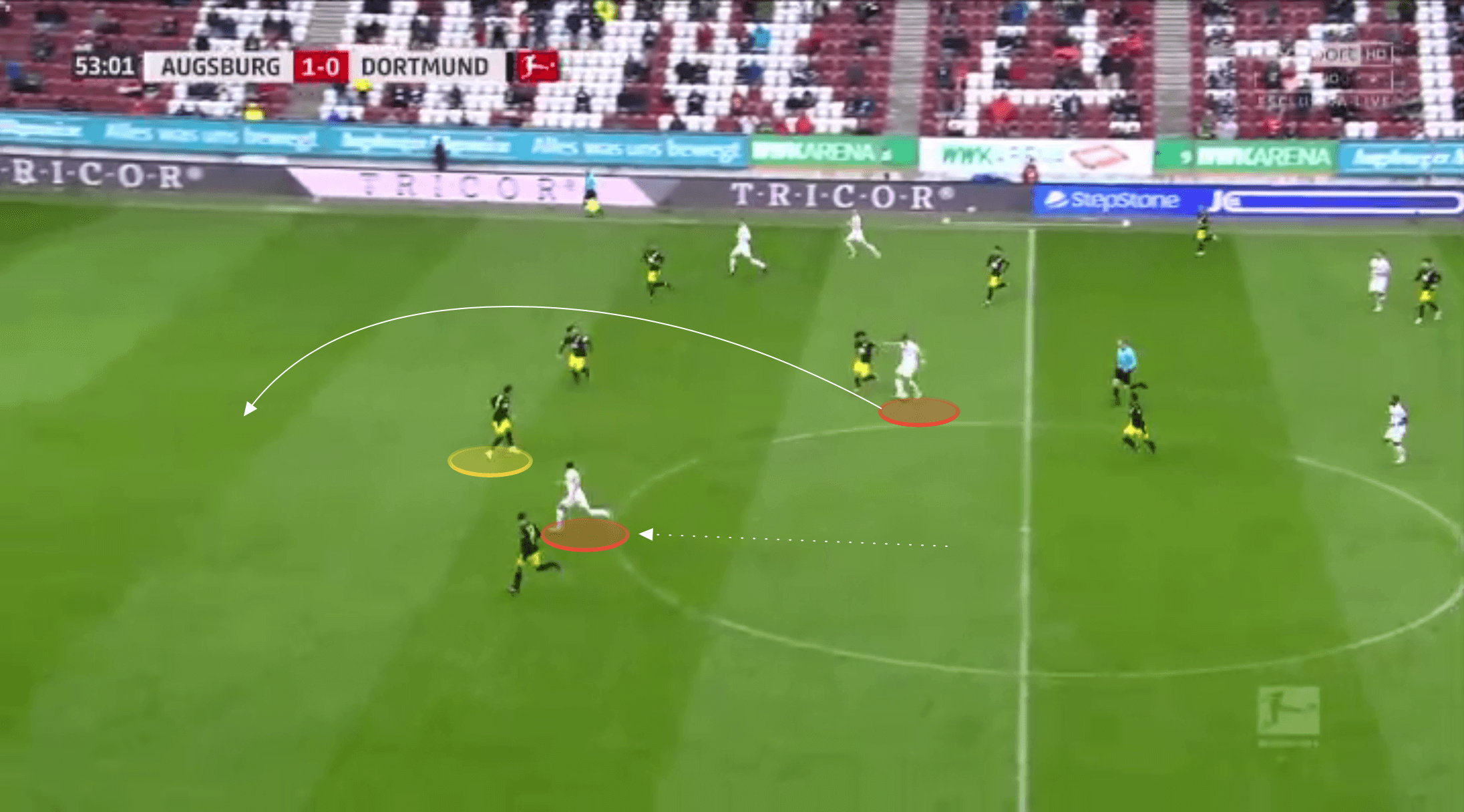
Leaving too much space for opponents to attack
The defence don’t just get exposed against counter-attacks too. Something that has been a feature under Favre is the oppositions’ attack being able to find space either between Dortmund’s defenders, or in between the lines of the defence and midfield in advanced areas.
A prime example of both of these things occurring in one moment was for Stuttgart’s third goal in the 5-1 drubbing with Philip Förster receiving between the lines in an advanced area and subsequently being able to burst through the gap between the two adjacent Dortmund defenders, before scoring.
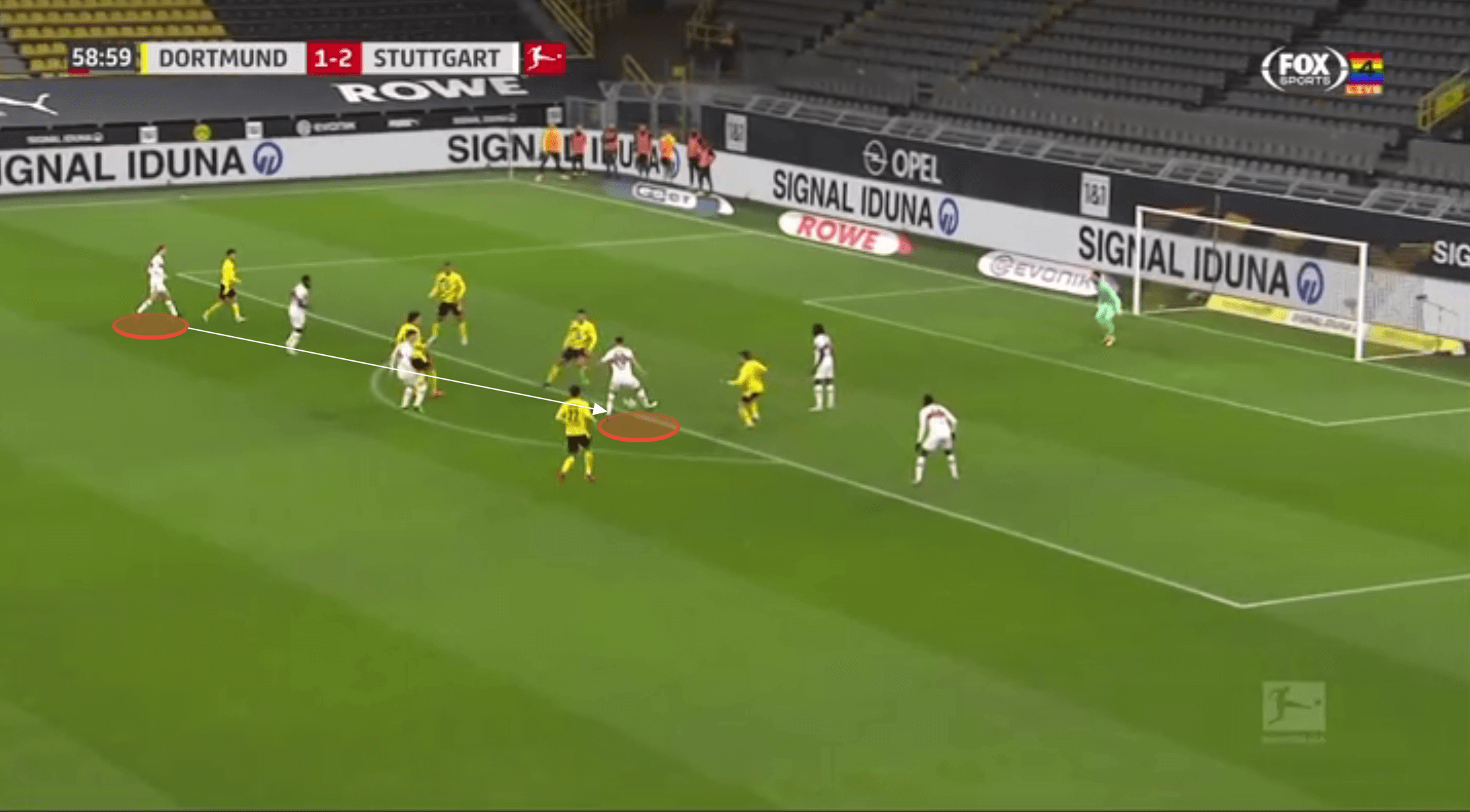
Dortmund’s back line struggle with their starting position as a unit covering the danger area, and then allowing players to sneak in between the gaps between them to latch onto crosses.
A common occurrence is to see them positioned too far towards the ball, where there is an absence of attackers. This can lead them to be overloaded and consequently stretched, as they are in the back post area in the image below. We can see three Leipzig attackers hitting this space, leading to Raphel Guerreiro being pulled away enough to allow Alexander Sorloth to hit the space between Guerreiro and his centre-back.
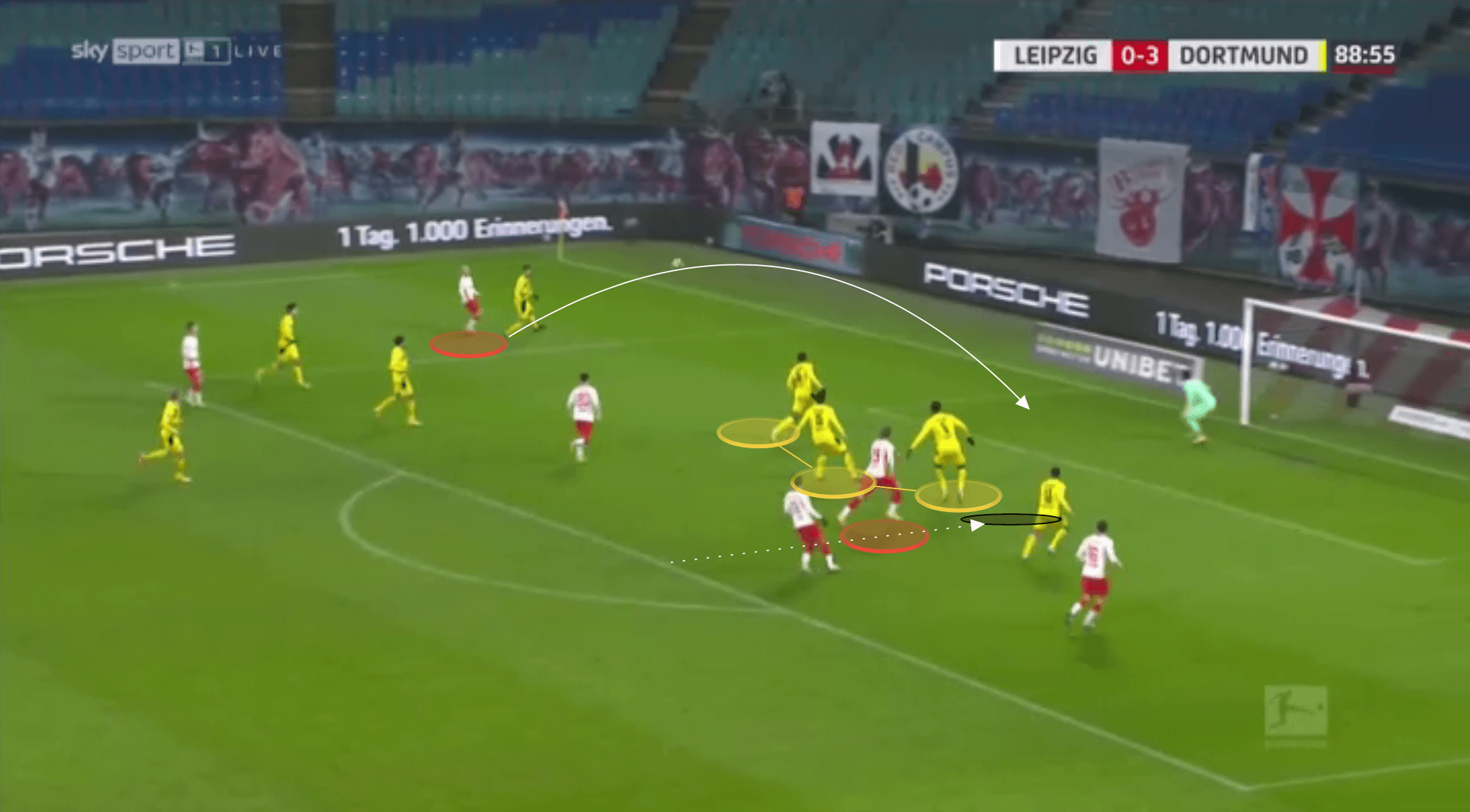
Again below, there is no need for Akanji to be as far over as he is. He can nullify the threat of Thomas Müller, who he’s marking if he is two to three yards closer to the centre of the pitch.
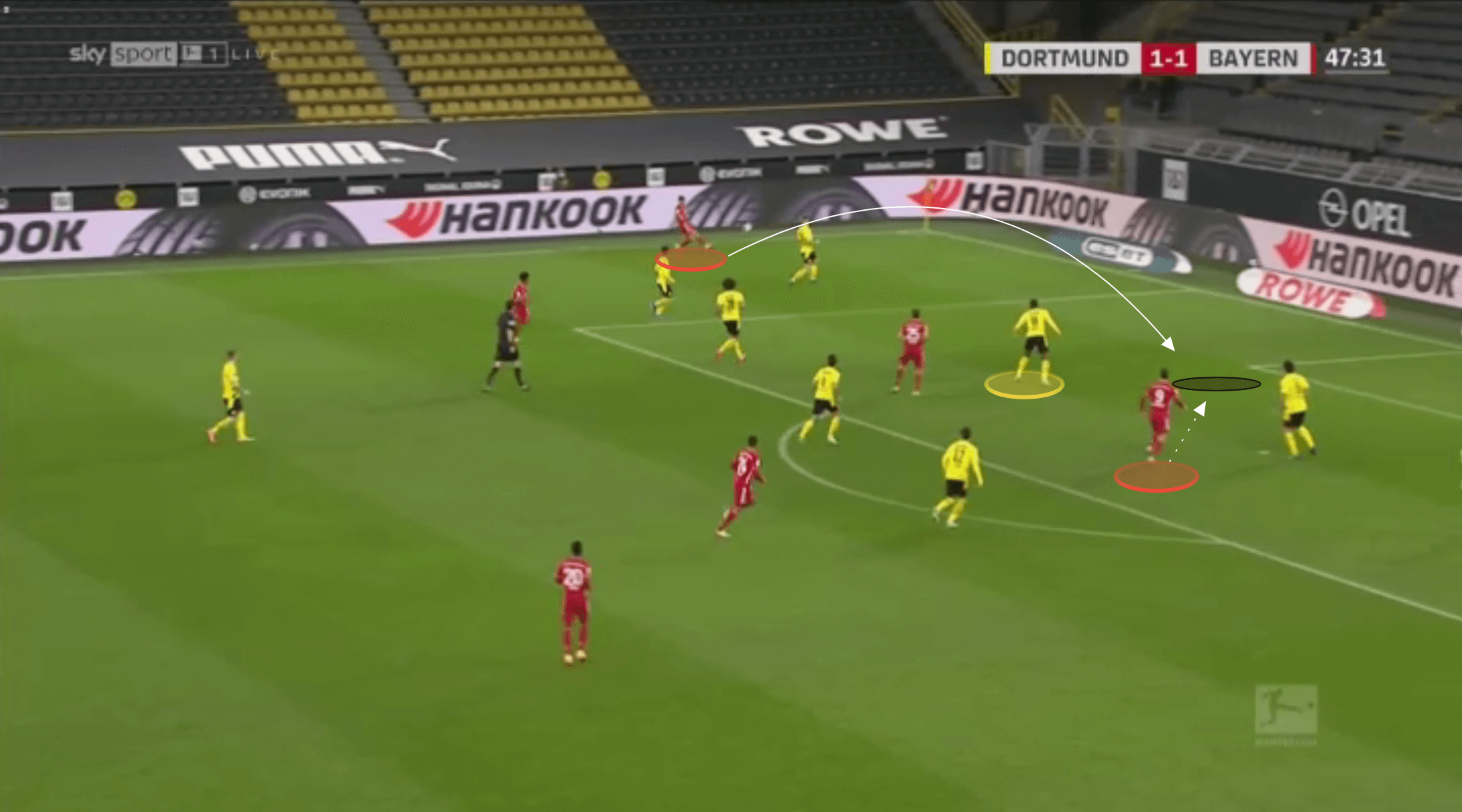
There is too much space between Akanji and Hummels, and Lewandowski is able to hit this area before heading home from the cross as Hummels struggles to get across and cover.
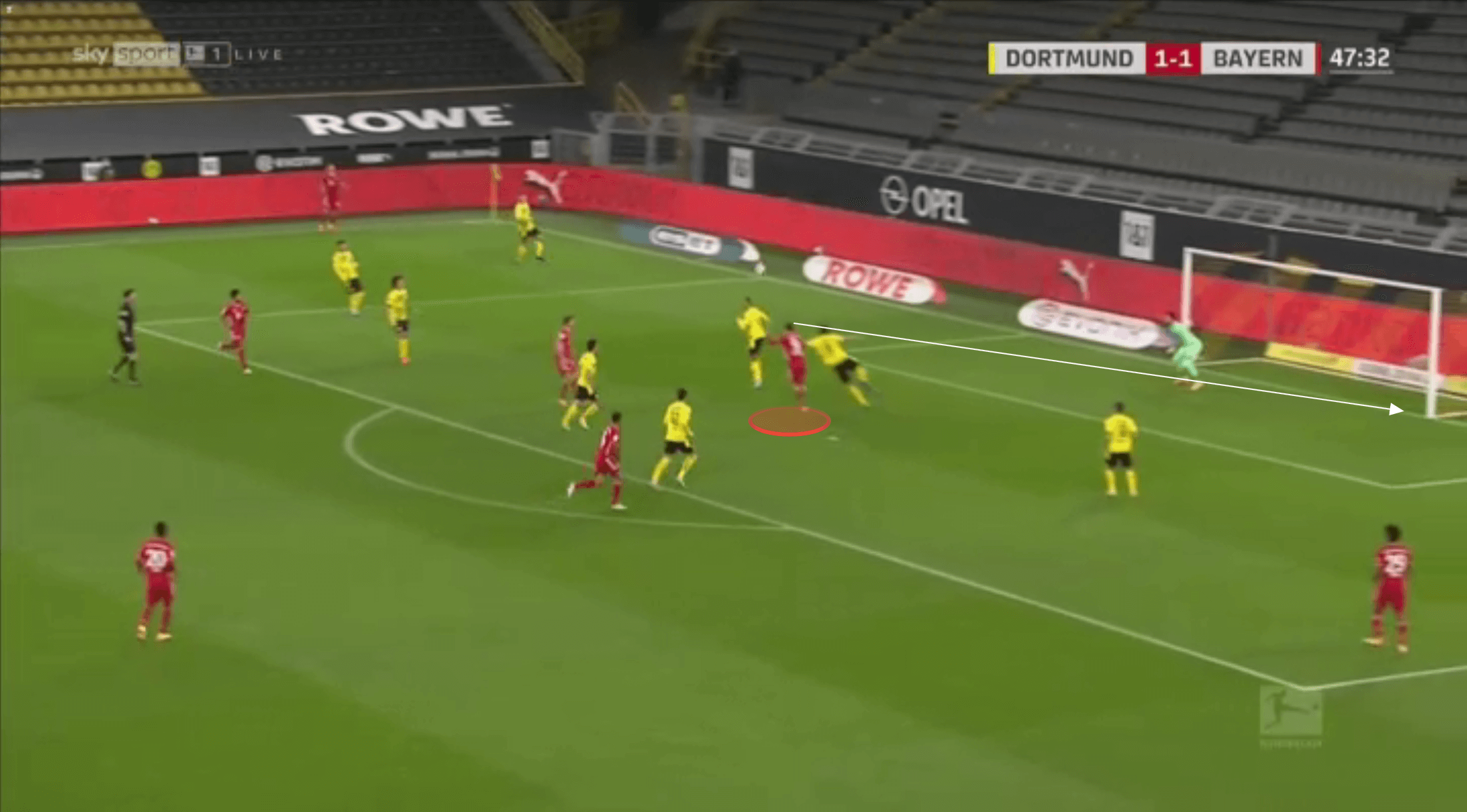
Defending from corners
Dortmund have conceded five from corners so far this season, and three of them have come from the exact same pattern.
Dortmund appear to have an issue with allowing players to move to the back post unmarked – or marked in the very loosest sense of the word. As the ball is whipped towards the front post, the player who has made this run is then able to score from close distance as the ball is either headed towards the back post or reaches this destination having missed everyone altogether.
Against Koln, all attention goes towards the ball being played towards the front. As this happens, Ellyes Skhiri peels away from his marker and moves towards the back post.
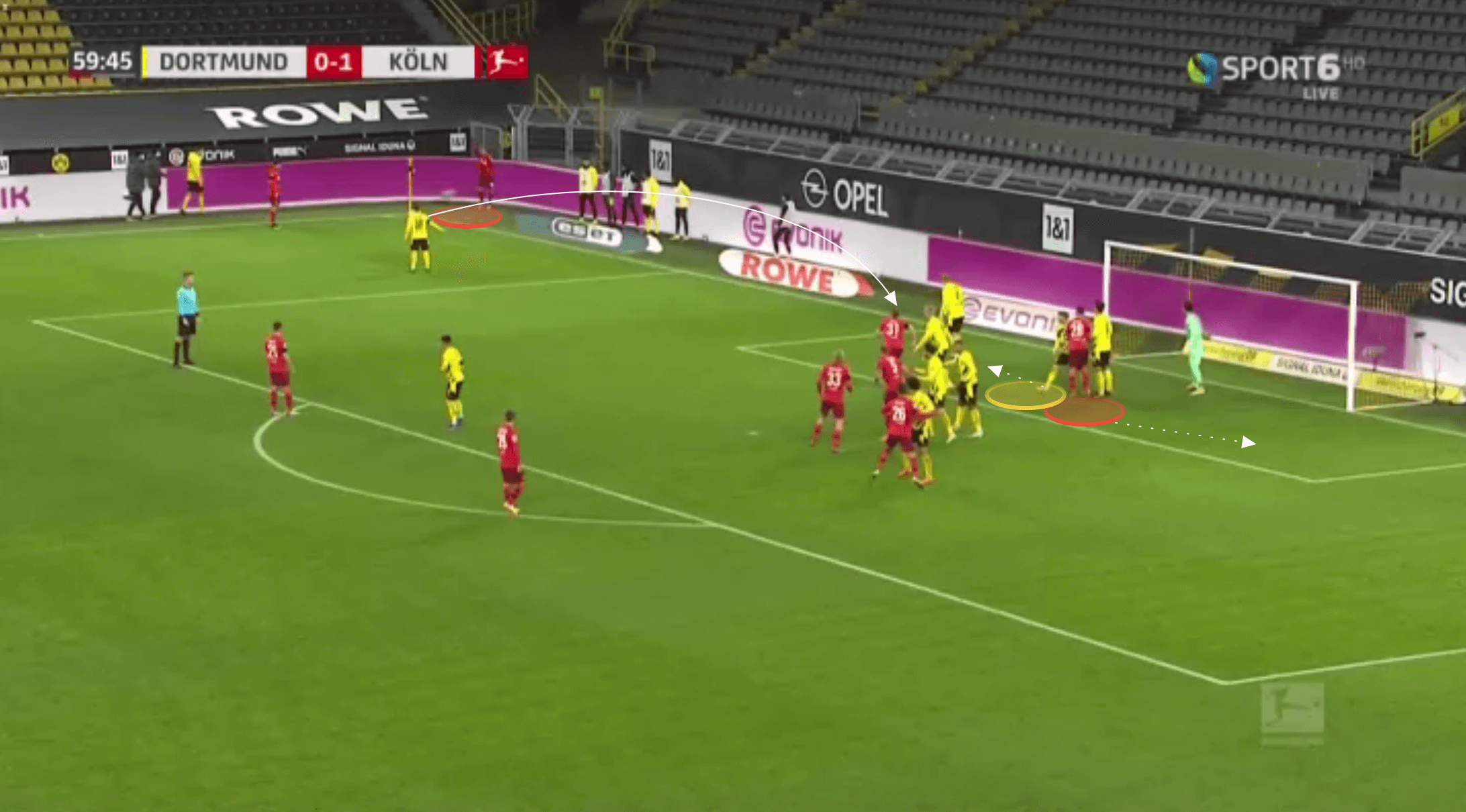
We can see how he is able to evade marking in doing so, and score from close range.
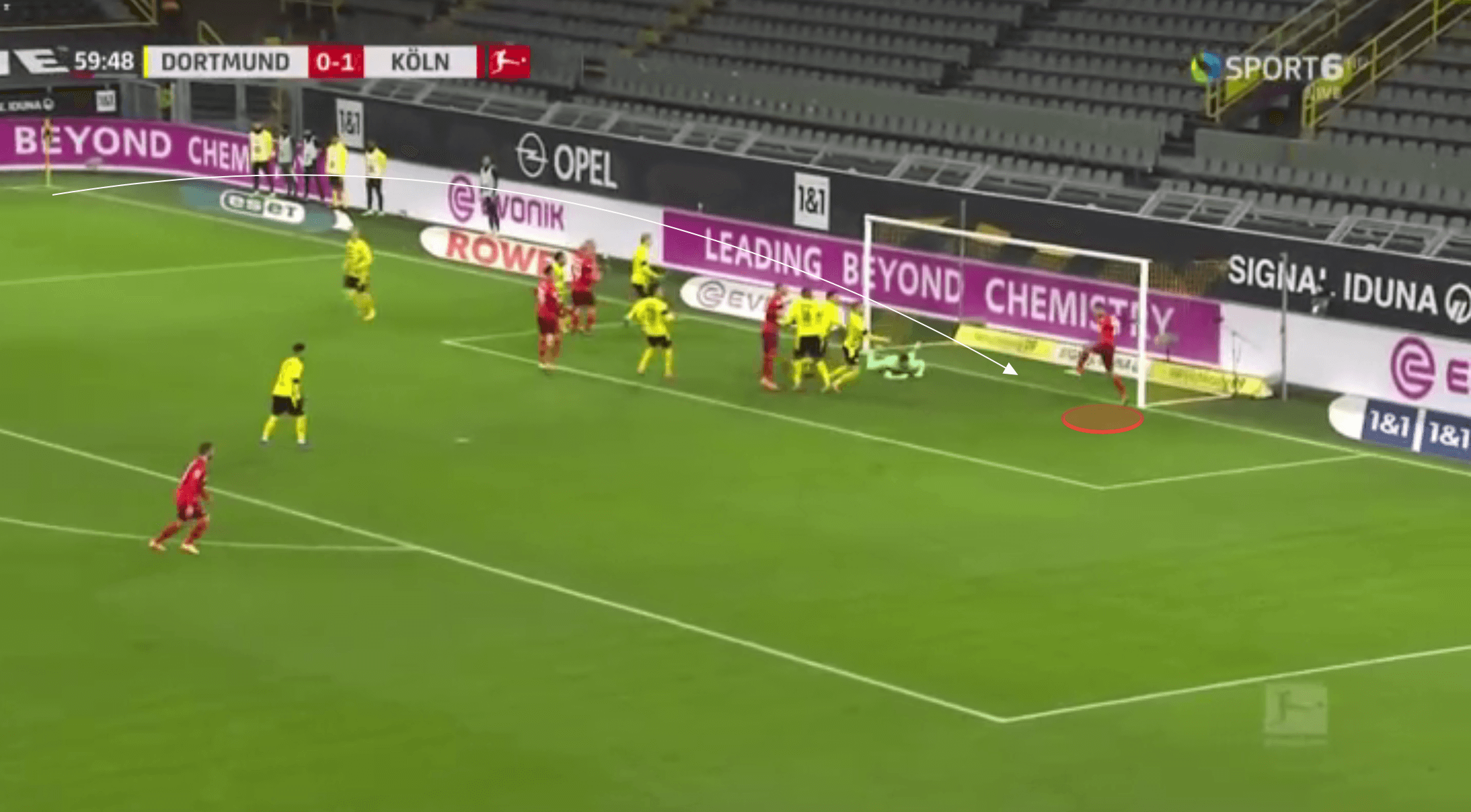
This one is a little more difficult to see due to the camera angle and quality of footage, but from the same game Skhiri initially scored by being able to move into this area unmarked.
Below he has been highlighted and he is immediately surrounded by three Dortmund players.
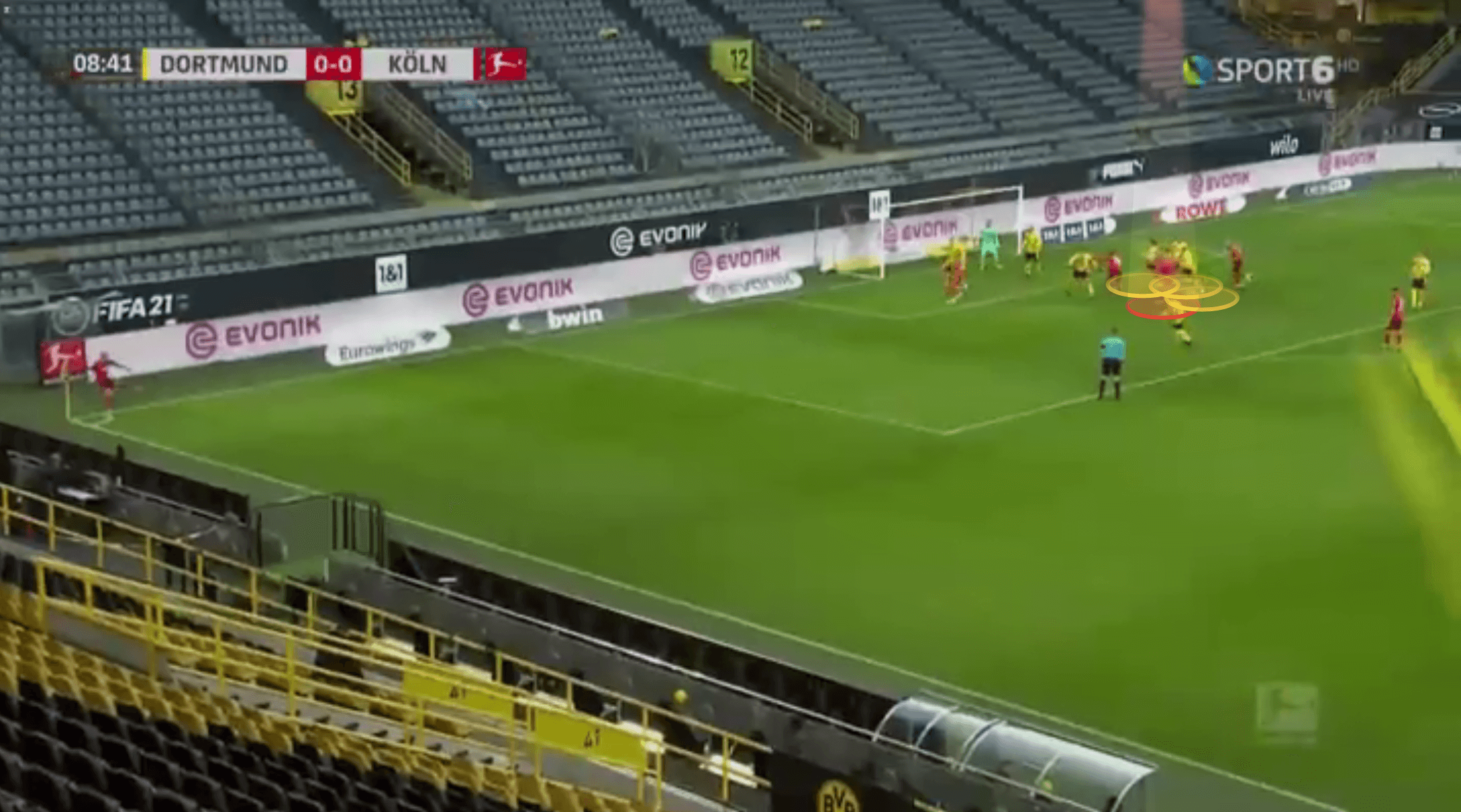
This time the ball goes through to Skhiri without being touched, but as we can see from the image below, he is able to move into this area without being marked as well.
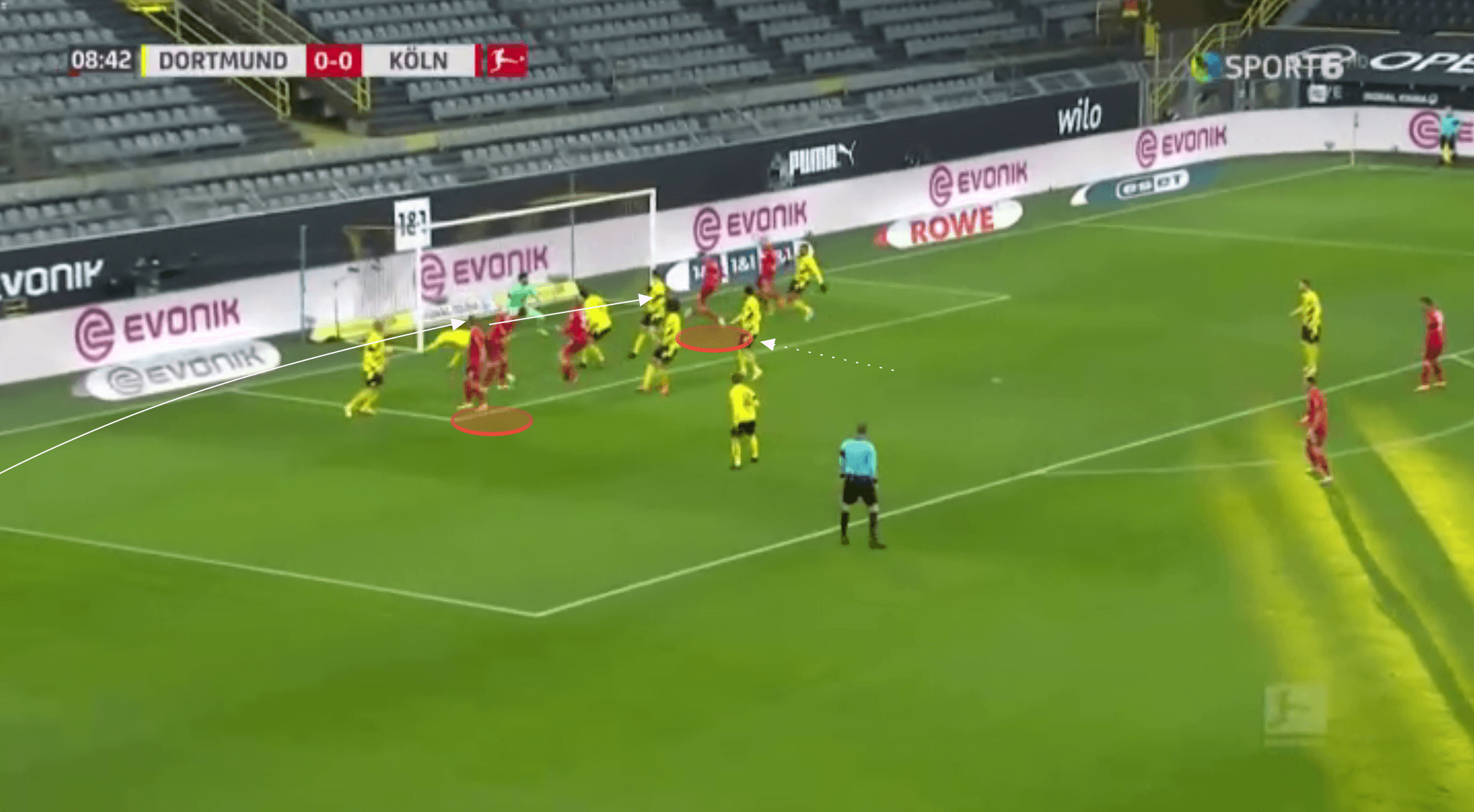
Both of these examples were from the same game, but it happened against Union Berlin too. Taiwan Awoniyi was able to loop around to the back post as the corner aimed towards the front post was headed on for Awoniyi to hit home.
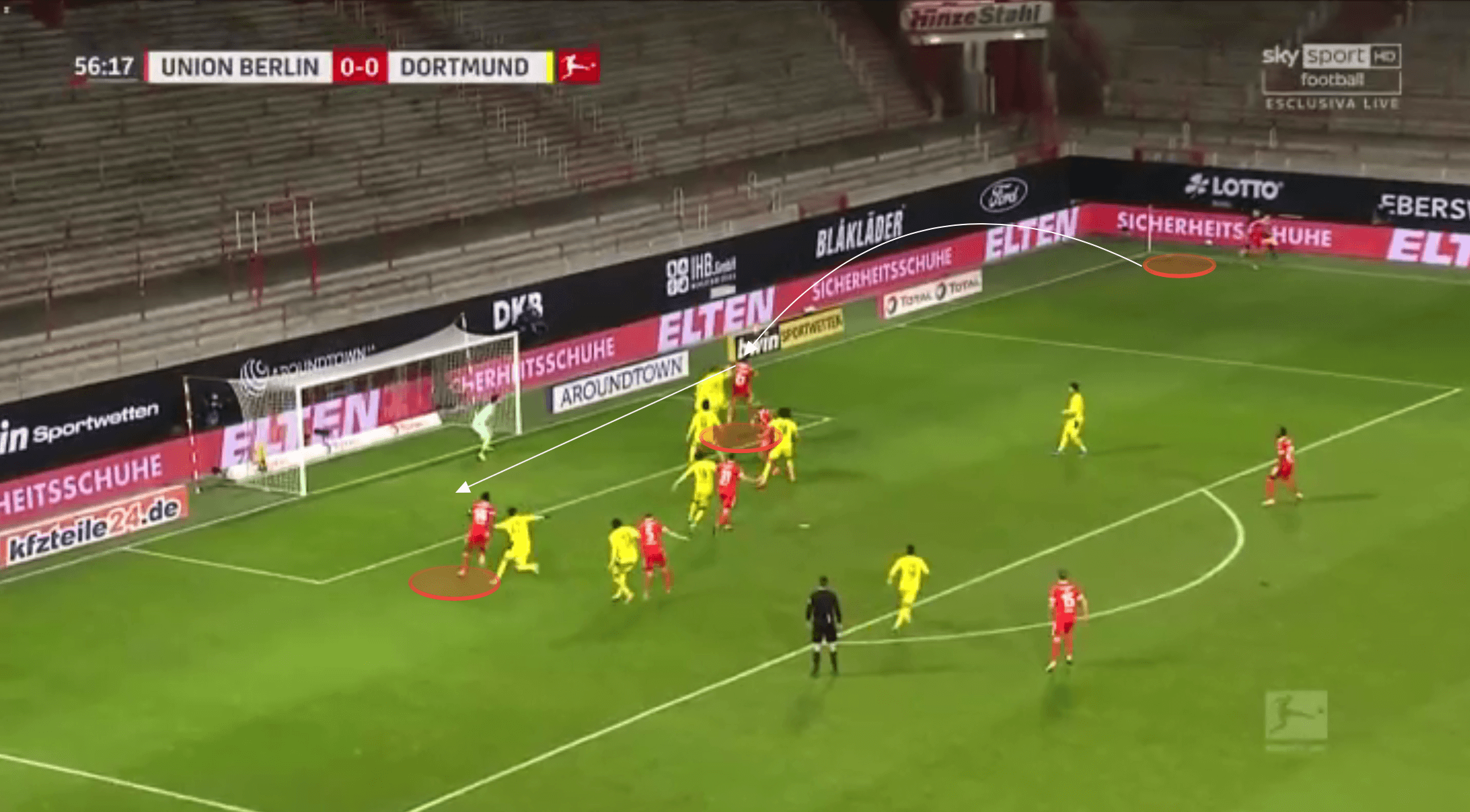
A player marking the corner of the six-yard-box and a player on the back post would go some way to nullifying this threat, if Dortmund aren’t able to improve in their ability to mark at corners or win the first ball.
Conclusion
It is easy to sit here and point out things that a team is doing wrong, but these aren’t new issues at Dortmund, and can’t continue to go unnoticed. For all of the individual attacking talent they have, Dortmund look noticeably weaker in personnel when we look at their defence, and there is a consistent naivety in defensive moments. A lot of the goals they concede are avoidable and with such a large number of clean sheets this season, they have shown they are more than capable of defending well on a regular basis. But they need to find a consistency to their defensive work and this can start by eradicating these basic errors that are allowing them to concede so many goals.




Comments